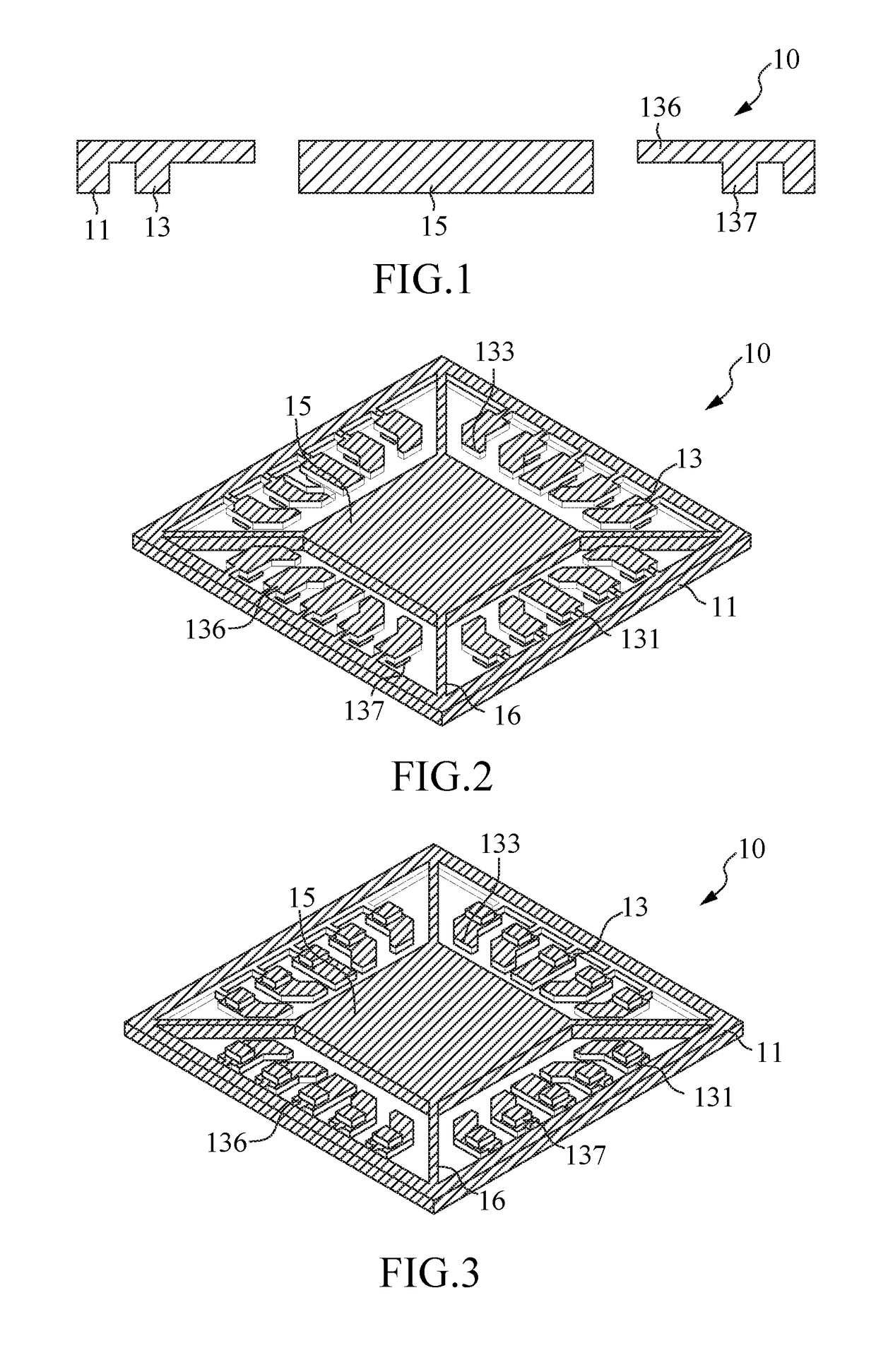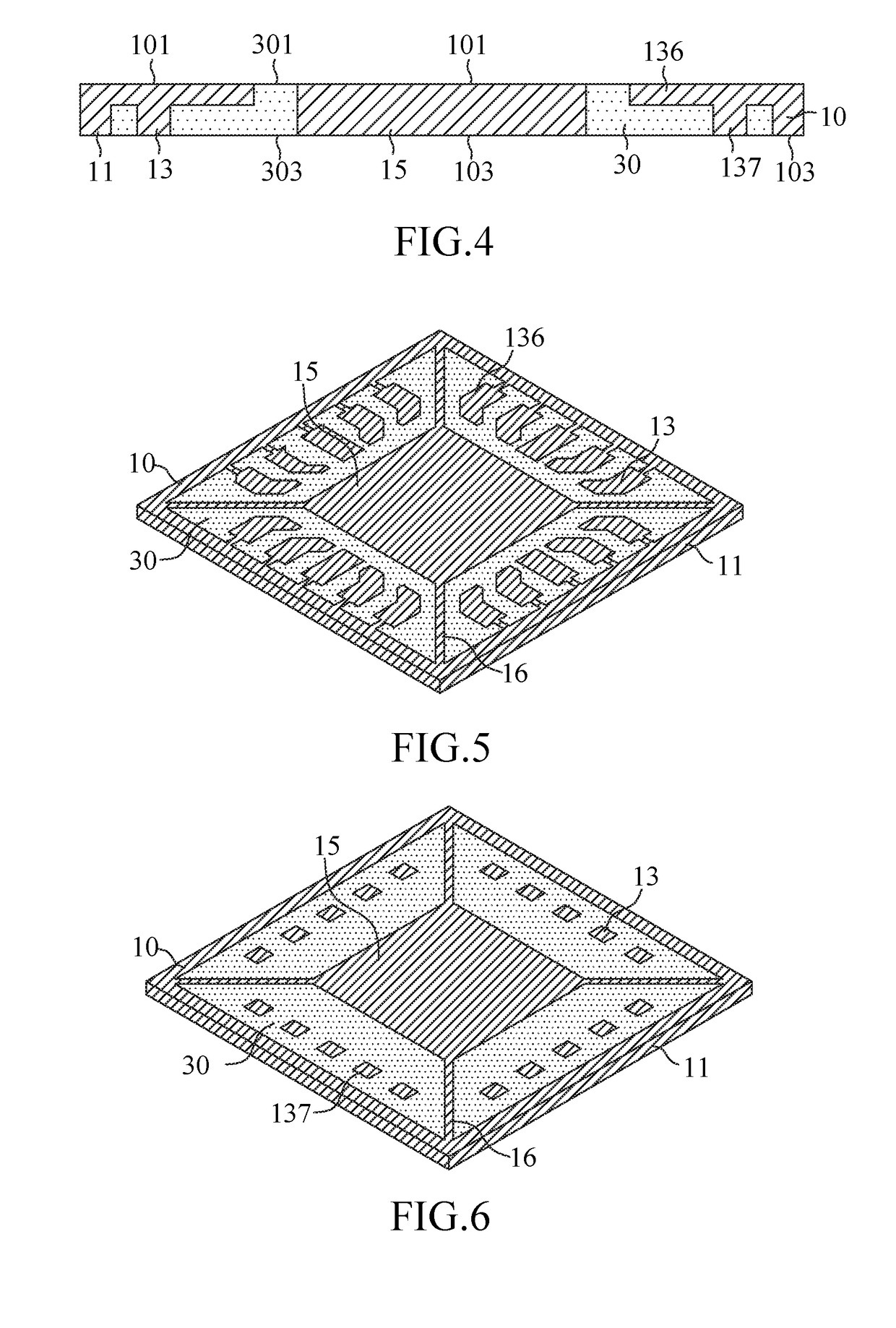Methods of making wiring substrate for stackable semiconductor assembly and making stackable semiconductor assembly
a stackable semiconductor and wiring substrate technology, applied in semiconductor devices, semiconductor/solid-state device details, electrical devices, etc., can solve problems such as sudden device failure and i/o disconnection, unreliable practical use of stacking structures, and solder cracking, so as to improve routing flexibility of wiring substrates
- Summary
- Abstract
- Description
- Claims
- Application Information
AI Technical Summary
Benefits of technology
Problems solved by technology
Method used
Image
Examples
embodiment 1
[0054]FIGS. 1-16 are schematic views showing a method of making a semiconductor assembly that includes a plurality of metal leads, a metal paddle, a metal film, a resin compound, a semiconductor device, a plurality of bonding wires and a molding compound in accordance with the first embodiment of the present invention.
[0055]FIGS. 1, 2 and 3 are cross-sectional, top and bottom perspective views, respectively, of a textured metal sheet 10. The textured metal sheet 10 typically is made of copper alloys, steel or alloy 42, and can be formed by a wet etching or stamping / punching process from a rolled metal strip having a thickness in a range from about 0.15 mm to about 1.0 mm. The etching process may be a one-sided or two-sided etching to etch through the metal strip and thereby transfer the metal strip into a desired overall pattern of the textured metal sheet 10 that includes a metal frame 11, a plurality of metal leads 13, a metal slug 15 and a plurality of tie bars 16. The metal lead...
embodiment 2
[0077]FIGS. 38-45 are schematic views showing a method of making a wiring substrate having a bottom build-up circuitry in accordance with the second embodiment of the present invention.
[0078]For purposes of brevity, any description in Embodiment 1 is incorporated herein insofar as the same is applicable, and the same description need not be repeated.
[0079]FIGS. 38 and 39 are cross-sectional and bottom perspective views, respectively, of the structure of FIG. 4 after removal of the metal frame 11. Removal of the metal frame 11 can be done by various methods including chemical etching or mechanical trimming / cutting. By separating the metal frame 11, the connection between the metal leads 13 is broken. As a result, the textured metal sheet 10 includes the metal leads 13, the metal slug 15 and the tie bars 16.
[0080]FIGS. 40 and 41 are cross-sectional and bottom perspective views, respectively, of the structure with a dielectric layer 531 formed on the textured metal sheet 10 and the res...
embodiment 3
[0087]FIGS. 50-61 are schematic views showing a method of making a semiconductor assembly having a semiconductor device attached on a resin paddle in accordance with the third embodiment of the present invention.
[0088]For purposes of brevity, any description in Embodiments above is incorporated herein insofar as the same is applicable, and the same description need not be repeated.
[0089]FIG. 50 is a cross-sectional view of a textured metal sheet 10. The textured metal sheet 10 is similar to that illustrated in FIGS. 1-3, except that it includes no tie bars and the metal slug 15 is thinner than the metal frame 11 and the metal leads 13.
[0090]FIGS. 51 and 52 are cross-sectional and bottom perspective views, respectively, of the structure provided with a resin compound 30 and a resin paddle 40. The resin compound 30 covers the lower surfaces of the horizontally elongated portions 136 as well as sidewalls of the vertically projected portions 137 and sidewalls of the metal slug 15. The r...
PUM
 Login to View More
Login to View More Abstract
Description
Claims
Application Information
 Login to View More
Login to View More - R&D
- Intellectual Property
- Life Sciences
- Materials
- Tech Scout
- Unparalleled Data Quality
- Higher Quality Content
- 60% Fewer Hallucinations
Browse by: Latest US Patents, China's latest patents, Technical Efficacy Thesaurus, Application Domain, Technology Topic, Popular Technical Reports.
© 2025 PatSnap. All rights reserved.Legal|Privacy policy|Modern Slavery Act Transparency Statement|Sitemap|About US| Contact US: help@patsnap.com



